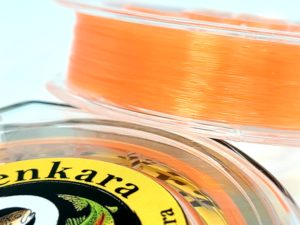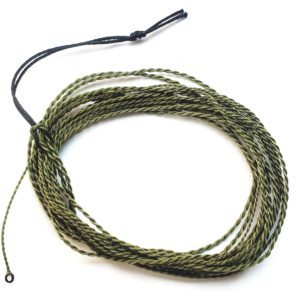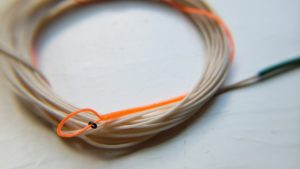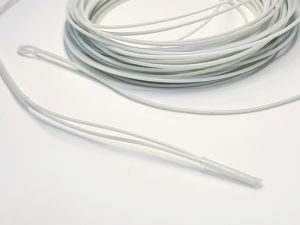Tenkara is all about simplicity but when it comes to line options it can get a little confusing. Let’s talk about the different kinds of tenkara lines that are available and how best to fish them.
Generally, I like to categorize tenkara lines into 5 categories: level, furled or braided, hybrid, floating and fusion. Each have their own set of pros and cons and cast better or worse on various rods. Knowing the benefits and limits of each type will help you chose when to use which line and the type of line that best suits your individual fishing needs. Even though there are options, it’s still pretty simple.
 Tenkara Level Lines:
Tenkara Level Lines:In the tenkara world when angler talks about level line, they are referring to fluorocarbon that has colorant added to it. This makes it more visible and easier to see than the typical clear fluorocarbon anglers use as tippet or leaders. Tenkara Level Line comes in spools, is usually dyed orange or red and is available in several diameters: #2.5, #3.0, #3.5 and #4.0 being the most common. The smaller the number the smaller and thinner the line. Tenkara level line is considered the most delicate and lightest line for tenkara rods and excels when fishing traditional tenkara flies like the Sakasa Kebari or regular dry fly patterns. It requires some finesse to cast this lightest and smallest line – more of a quick-flick action gets it out there. These lines are fished as a short, tight “traditional” tenkara setup. Because it is fluorocarbon it sinks. This is why it should be fished “short” (approximately the length of your tenkara rod and kept tight and off the surface of the water – because it will drag your fly down as it drops in the water and is the reason why anglers often use “fluoro” tippet when nymphing). If you desire an ultralight, fly-first presentation and require only a short cast, consider fishing with tenkara level line for a traditional, super delicate tenkara presentation. Most tenkara rods on the market will cast a #3.0 or a #3.5 level line well. Keep in mind the lighter the line the more finesse it takes to cast. Also keep in mind that tenkara level line has lots of memory and coils like a Slinky, which some anglers find annoying and frustrating to work with. Since it comes spooled, you can cut it to any size, but you will also need to tie your own connection knots or make your own loops. These features are not built into the line requiring a little more work and tying by the angler. One additional note, because these lines are so light and delicate, they can be difficult to cast and fish in wind often making it near impossible to keep your fly in or on the water. Since these lines sink, laying your line on the surface of the water to avoid the wind will not work.
Fish tenkara level lines in small creeks and streams, areas protected from excessive wind, with tenkara fly patterns and regular, small, dry fly patterns and when you desire that ultralight, super delicate, short, fly-first, cast and presentation.
 Furled and Braided Lines:
Furled and Braided Lines:These lines are similar to furled leaders used in the regular fly-fishing world. The nice part is that they have connect loops so attachment to your tenkara rod is quick and easy with a girth hitch and all you need is to tie a section of tippet to the end loop. Some furled and braided lines also have tippet rings which keep your line from fraying and from accidentally getting snipped when cutting off old tippet – which is an unrepairable “oops”. Furled Tenkara Lines are the heaviest of all tenkara line categories thus making them the easiest to learn casting on for beginners. Because they are heavy, they exaggerate the load feedback you get when casting a rod and help novice anglers learn cast timing. Furled and braided lines will “stretch” a bit, particularly if they get wet and absorb water, which is why they are meant to be fished off the surface of the water with a fly-first presentation. If these lines do get wet, they will spray water during the cast and this disruption can spook fish. When using these lines, make sure to keep your tenkara rod tip up high, and your furled or braided tenkara line dry and off the water.
Easy to cast and great for beginners, tenkara furled and braided lines are designed to be fished short and tight on smaller creeks and streams. They will cast through wind well since they are heavy. Tenkara furled and braided lines are commonly made of a Uni Thread but are also available in a Kevlar material which is even denser and is also more durable and resistant to fraying. Look for lines that are a tight, compact weave and that include a tippet ring as well as the connect loop. A nice tight weave will make them cast better, stretch less and absorb less water if they do take a dip. They will also last longer and are considered higher quality than loosely furled or braided lines.
Tenkara Hybrid Lines:
Fluorocarbon or nylon lines of different diameters tied together in a tapering fashion to help make them easier to cast but end with a section of finer level line – often with the first section of fluorocarbon or nylon also being furled or braided to increase its density, then transitioning into level line sections. These lines start with a heavier line near the top where they connect to your tenkara rod. They generally have a pre-constructed loop already tied in, often made from fly line backing, then taper down to smaller and finer diameter line sections, to end in an unfinished and cuttable end-tip. The nice part is that you have some degree of customization since you can trim the end to your desired length. You will still need to create your own tippet loop or tie a knot, to attach your tippet to the end of the line since there is no tippet loop built in. Since these lines start with a heavier top section, they are easier to cast than the typical spooled tenkara level lines. They taper to a finer section so still provide a soft presentation. But, since they are made of a heavier fluorocarbon or sometimes a nylon material, they have tons of memory and coil like crazy. You will need to stretch and straighten these lines to have them cast well, especially with a very light fly pattern. The benefit of this style of line is that they are easier to cast and have at least a connection loop to the rod. Plus, you have some degree of length customization (typically about 1-3 feet of wiggle room) since you and trim the unfinished end. Because of their additional weight, they will perform better than straight tenkara level line in wind and if made of nylon will float for a short while with a very light fly if you would need to lay your line on the water surface for any reason.
Fluorocarbon or nylon lines of different diameters tied together in a tapering fashion to help make them easier to cast but end with a section of finer level line – often with the first section of fluorocarbon or nylon also being furled or braided to increase its density, then transitioning into level line sections. These lines start with a heavier line near the top where they connect to your tenkara rod. They generally have a pre-constructed loop already tied in, often made from fly line backing, then taper down to smaller and finer diameter line sections, to end in an unfinished and cuttable end-tip. The nice part is that you have some degree of customization since you can trim the end to your desired length. You will still need to create your own tippet loop or tie a knot, to attach your tippet to the end of the line since there is no tippet loop built in. Since these lines start with a heavier top section, they are easier to cast than the typical spooled tenkara level lines. They taper to a finer section so still provide a soft presentation. But, since they are made of a heavier fluorocarbon or sometimes a nylon material, they have tons of memory and coil like crazy. You will need to stretch and straighten these lines to have them cast well, especially with a very light fly pattern. The benefit of this style of line is that they are easier to cast and have at least a connection loop to the rod. Plus, you have some degree of length customization (typically about 1-3 feet of wiggle room) since you and trim the unfinished end. Because of their additional weight, they will perform better than straight tenkara level line in wind and if made of nylon will float for a short while with a very light fly if you would need to lay your line on the water surface for any reason.
 Floating Tenkara Lines:
Floating Tenkara Lines:In the tenkara world there are a few different floating lines. For our purpose today, I am NOT referring to lightweight fly line that has been cut in lengths and then has a section of fly line backing attached with a nail knot or otherwise to create a connection loop. These are “craft project lines” and can certainly be made and fished but are not what we are talking about here. For our purpose, a “tenkara floating line” is a line designed, created and manufactured for the sole intent of being paired with a tenkara rod and is built specifically for that purpose from novel material…. Essentially not a fly-fishing craft project or a line made from cutting up other lines, but a unique product made with unique material. Currently there is only one manufacturer of this type of product, Zen Tenkara. These are “All Purpose” tenkara lines that also float. These lines are extremely light and are comparable to tenkara level line #3.0 in diameter. They are designed with a zero memory, zero stretch, supple interior core that then gets an ultrathin extrusion coating that gives the lines their float quality, while also giving them a slick, smooth finish to reduce friction and the ability to add a colorant. These unique lines have manufactured welded connection loops at both ends plus a tippet ring. To help with visibility an 8″ bright orange section is used at the end of the line as a hi-vis sight indicator. The lines give you the option of tying on straight tippet to the tippet ring and fishing it “traditionally” with a short, tight setup or, adding a tapered leader with a loop-to-loop connection to the small end loop to instantly add length to the line. In an instant you can complete longer casts to reach and cover more and bigger water. Since the line floats, your fly won’t be dragged down when doing this. Tie on fluoro tippet to the tippet ring, and you have an excellent tight line nymphing setup with a hi-vis sighter. With a no stretch line, your hook sets are easy. Available in 6 different lengths from 7ft on up to 22ft, these lines allow you to fish a variety of waters in a variety of ways. They also have an 18lb test so going big, even though they are super light, is no problem. Because of their dense inner core, they cast easily though wind and lay out soft and straight since they have almost no memory.
Floating Tenkara Lines can be used for short tight setup or for long casting. They offer the tenkara angler flexibility and floating qualities without giving up delicateness.
 Tenkara Fusion Lines:
Tenkara Fusion Lines:Love the ease and simplicity of tenkara but the fun of a full cast? These lines might interest you. Fusion Lines are a novel product with a unique design, created and manufacturer by Zen, specifically for tenkara rods. Fusion Lines take the best of both worlds – tenkara and regular fly fishing and fuses them together to make an exclusive line that can be fished on or off the surface of the water but is generally intended for those anglers who like to cast. They are a heavier line that load most tenkara rods in a slow, smooth and fluid fashion that lays the line out straight and silky. Mostly they are used with regular fly patterns and will give the angler a “syrupy” smooth and rhythmic cast. They are designed for longer casts and made in 3 grain weights and offered at several lengths. Two of the weights (Light and Mid-Weight) are level lines. The Big is a unique double tapered line. These lines cast extremely well in wind but are delicate and fine enough to land soft and delicately. They can be used for both cold and warm/fresh and saltwater applications. These are new to the tenkara world and offer a blending and blurring of tenkara and regular fly-fishing worlds.Simplicity isn’t optionless. The tenkara angler still has choices. Each of these lines offers a different casting and fishing experience to the tenkara angler. Some excel in certain scenarios better than others. Some are easier to learn on and some can offer a unique experience. Experiment and play with lines and line lengths. If you always fish the same water, this may add a whole new dimension to a familiar stretch and entice you to grow and discover. When you travel to new destinations, be prepared. Ask a local fly shop about their water: average casting distance, depth, species size, fly patterns that work best and river or stream bank conditions (lots of tree coverage, freestone, steep banks, etc). All of these factors will impact the line type and length that would be most effective to use. This information will help you decide what type and what length of line will work best. Make your best guess then pack along a few extra options just in case.
By having a few selections of line, you will always be prepared and never miss out on a fishing opportunity due to the limits of your line. Your line wallet should be your most prized possession and most valuable take-along piece of gear besides your rod. Knowing your line types and understanding their benefits and limitations, will help you keep it simple and ensure your effectiveness while on the water.




Just curious as to you objection to making tenkara line out of floating fly line? Just learned how an it works great.
Hey Orlando!
Thanks for reading. We have no objection for you to make lines out of floating fly lines. It just becomes a craft project. Some people enjoy that, others don’t. Our All Purpose Tenkara/ Floating Lines are not fly line but rather a proprietary line of very small diameter with little to no significant stretch. It has a built-in welded connection loop that has a tag end for easy on and off, and is color coded for quick length identification. That line also has a built-in high vis sight indicator and gives angles the option of using the tippet ring or doing a loop to loop connection. It’s easy to cast and has almost no memory so it’s super sweet.
Our Fusion Lines are custom grain weighted for us, have built-in welded connection loops. They have tag ends for easy on and off and our next round will be color coded too. Plus our Big Fusion Line has a unique custom double taper that allows angler to achieve two different presentations and turn over rates. So a lot of thought and effort went into their design. We didn’t just slice up fly line. But noone says you can’t do that. And actually that how it all started and our ideas came from. Owner Karin Miller started cutting up old fly line to cast on her tenkara rods, and liked the feel. So great question! Thanks for your curiosity. Reach out to us through the contact page if we can ever help or brainstorm with you.
Just started tenkra
fishing using the bright level line first time out I caught a bunch of three and four pound rainbows what a great time thinking about trying the floating line next thanks 👍. Bill from Utah
Congrats Bill! Sounds like you’re having fun. The Fusion Lines are great and cast super easy. Reach out if you have any questions. Always happy to help.
I am just starting in Tenkara. I have fly-fished since I was a child, and now 76. I live in Louisiana and used to take a month-long pilgrimage out west each year but most of my fishing is local warm water lakes. I do quite well on wet flies and buggers as well as dry flies and small poppers. I am pretty well rigged out with level line and furled but was wondering if I should also give floating line a shot as well. I am also wondering about the fusion lines in your article. Which one do you think would be best? I have yet to cast my Tenkaras even once. My fly casting with a traditional rod would likely be considered excellent but I am sure I have much to unlearn. Love the article by the way. Very informative.
Very glad you enjoyed the article and hopefully found it helpful. You sound like a very experienced fly angler. May I know what kind d of tenkara rod you have. You said you have not yet used it so you have not yet cast your furled or level lines yet I am assuming? Bit more information about the rod you “plan” to use would be helpful.
Hi there,
I purchased your Suzumi zoom rod today, looking forward to using it in the backcountry as a small stream rod. My question is: what is the usual length of line to use when you’re rigging up a zoom rod? Should I carry different length lines for the different lengths as I apply them? It seems that might sorta defeat the simplicity somewhat. I’m used to working with a specific rod and appropriate line. Thanks in advance for advice. Looking forward to meeting y’all at the Denver Fly Fishing Show!
Hi Jeff and thank you for choosing Zen Tenkara. The Suzume is an awesome rod. I am certain you will enjoy it. When it comes to lines there isn’t a right or wrong. It generally boils down to personal preferences and the way and environment you’re fishing in. Personally, when I fish the Suzume rod I find myslef using the mid-length most often. I then tend to zoom down smaller or little bow and arrow casts into pocket water or small pools, and extend the rod fully if I come to a beaver pond or the water opens up – or I arrive at a high mountain lake. The size of the water and the cst required is what typically determines the length of line you need. Most of the time I use an 7ft or an 11ft Zen All-Purpose Tenkara Line on the Suzume. If Im using the 7ft line and I add 4-5ft of tippet, the setup is still pretty short and tight in all 3 positions. I can always shorten or length my tippet – or even add a 7t RIO tapered trout leader and really extend the line. If I planned on fishing a mountain lake, Id pack along one of the Zen Fusion Lines Light in the 20ft length and add my tippet to that. If I’m in really tight, cramped water with overhanging trees and lots of brush, I’m keeping everything short and tight, using a 7ft line with about 3-4ft of tippet and bow and arrow casting in between bushes and growth or tight lining over a boulder. It really depends on the water. Start off with either a 7ft or a 11ft line and know you can make adjustments to your tippet length – then go from there. The more you fish the Suzume, the easier it will be to figure this stuff out. It seems complicated but I promise it isn’t. Keep in mind, there may be an occasion where you just can’t reach a fish – that’s life. Let it go, walk down the river 8ft and you’ll find another one you can reach. That’s tenkara. Please reach out with any other questions. Always happy to help and brainstorm any issues. Tight lines and happy fishing!